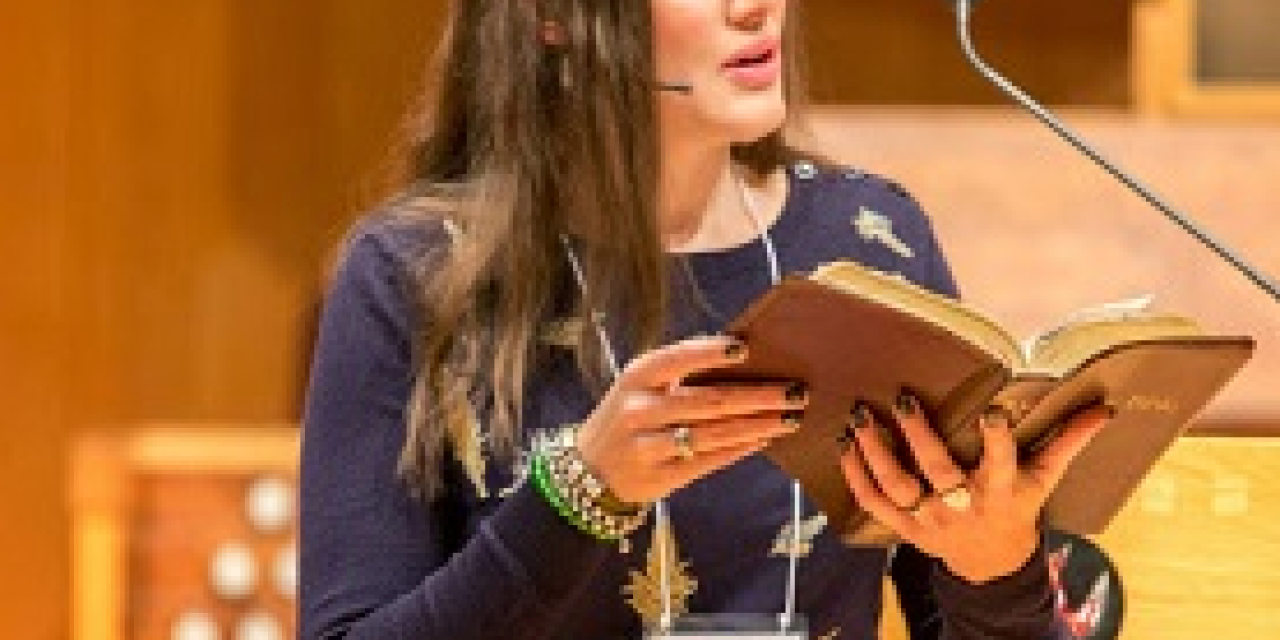Joy-Elizabeth Lawrence is a writer, speaker and biblical storyteller. She is earning an M. Div. at Calvin Theological Seminary. She has written and directed dozens of choral Bible readings. In this edited conversation, she explains when and how to present scripture as a choral reading in worship.
How do you decide whether a given Bible passage is a good candidate for choral reading?
I really enjoy doing choral readings from the Psalms and Prophets. Revelation and parts of Job would make some great choral reading. The Epistles are harder, especially Paul’s, because the sentences are often so long. If it’s a narrative passage, I’m less likely to do a choral reading. There are so many other options for narratives—biblical storytelling, tableau, enactment or reader’s theatre.
I think of the human voice as an instrument. Voices with different pitches, resonances and timbres can sound like a chord in a song. The sounds of their voices—or how you divide their voices—can show the meaning in a Bible passage.
What’s the difference between reader’s theatre and choral reading?
Reader’s theatre uses an individual voice for each line. There’s no movement, but you read with lots of meaning and emotion, as you would when reading or trying out for a play. Choral reading is usually done by a group of six to eight people, often speaking as one voice.
How do you find people in the church who can do a choral reading?
Jeff Barker, in his book The Storytelling Church, says it can be challenging to hear a group speak together. So often when a congregation reads together, people are focused more on reading in unison than on the meaning of what they’re reading. But choirs can do a choral reading quite well, because they’re used to singing and breathing as one.
What are the steps to creating a choral reading for an appropriate scripture portion?
When I get together with a group I don’t know, I invite each person to say something, which lets me hear who seems to have had some voice training. I give solos to those people. Hearing people speak helps me to arrange them into soprano, alto, tenor and bass parts. (Women can do tenor and bass.)
We spend time together reading the text aloud and meditating on what the text means to us personally. We need to experience what God is saying in the text to us, and then, in our vulnerability, we can communicate it in worship. It’s also important not to equate personal meaning and opinion. Someone might read Psalm 90 and say, “This shows us that God wants all of us to worship together.” The leader can redirect by asking people to think about an older person who has influenced their faith or the hope they feel for the life of someone they’re mentoring. These discussions will give a lot more meaning as people do the choral reading. And we always talk about what image the passage is trying to emulate and which voices will convey that.
Can you give an example?
Psalm 90 begins: “Lord, you have been our dwelling place in all generations.” This would be a good place for a duet of an older voice and youthful voice. Maybe you could bring in a grandparent and grandchild. You might use bass voices for “Before the mountains brought forth” and alto voices for “or ever you had formed the earth and the world.” Bass and alto together could say “from everlasting to everlasting, you are God.”
How do you rehearse and present a choral reading?
If your script doesn’t sound right in rehearsal, then change it and reassign parts and phrases. Rehearsal is the place to experiment with expression. People with no choir or acting experience often prefer to do a very neutral reading. But whatever we do is communication. If we communicate in a neutral way without expression, we might be communicating that the Bible is not very important or interesting. Being overly dramatic is also a problem. In rehearsal, though, it’s fun to push the drama too far. That helps people recognize what’s enough.
Sometimes I work with students who feel hesitant or embarrassed to read expressively. I tell them, “If you feel self-conscious, people will notice and it will bring attention to you rather than to the scripture text. You have to have confidence in the Word and the Holy Spirit. In the theatre we tell actors to commit to their choice. Having confidence in that will take eyes off you and onto the story.”
What have you observed when choral reading is done well in worship?
Readers experience a new kind of interaction with the text. I recently worked as a clinician for a wonderfully intergenerational church group. We did our workshop on Mary’s visit to Elizabeth. People hadn’t realized how young Mary was or what an upside down gospel we see in the Magnificat. I hope the experience gave people a deeper sense of the dignity of young people, and the conviction that God can use young people.
It can take time for congregations to learn how to experience and benefit from choral readings.
How do you find choral readings that have already been composed?
You can search online for “’choral reading’ Bible,” “enacted scripture” or “scripted scripture.” I find scripts on re:Worship, a compendium of new worship resources. There are lots of choral readings in the online Rereading the Bible Again (for the First Time) by George Scranton.
Browse choral readings arranged by Joy-Elizabeth Lawrence. Read parts one, two and three of her fantastic series in Christianity Today about playing with scripture in worship.

